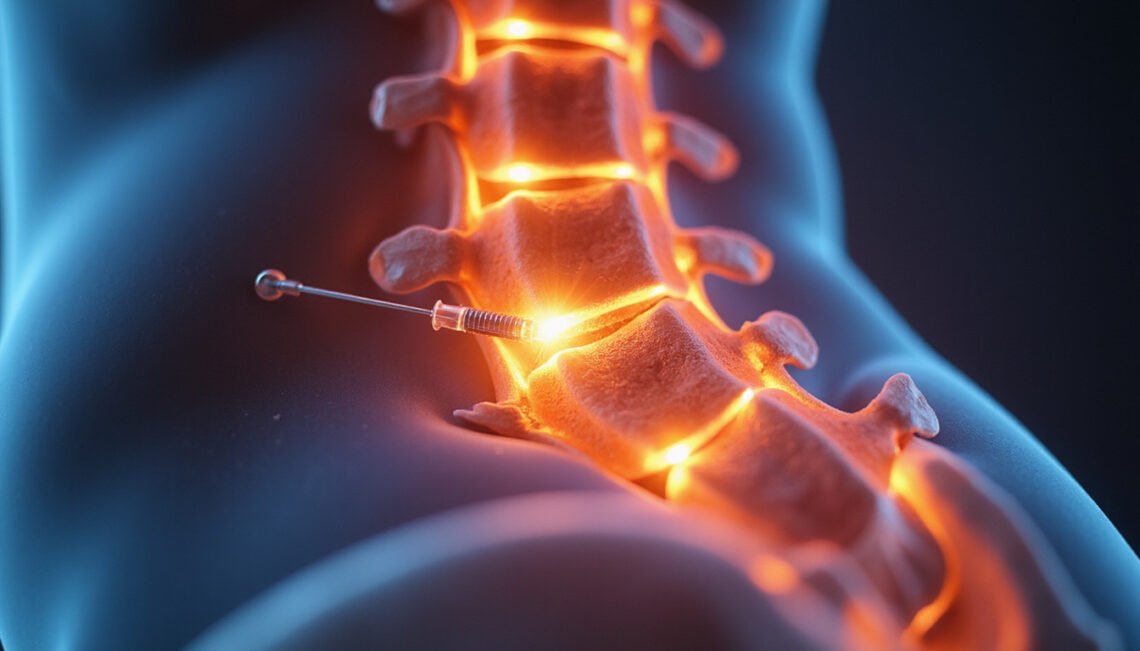If you’re considering an epidural steroid injection to treat back pain or sciatica, a common question is: how long before pain relief? An epidural steroid injection can reduce inflammation around spinal nerves, but timing and effectiveness vary. This guide explains typical timelines for relief, what affects results, possible risks, and how to prepare and recover so you can make an informed decision with your clinician.
How epidural steroid injections work
An epidural steroid injection delivers a corticosteroid and often a local anesthetic into the epidural space — the area around the spinal cord and nerve roots. The steroid reduces inflammation and swelling that irritate nerves, while the anesthetic provides short-term numbing. Some patients feel immediate relief from the anesthetic, while the steroid may take longer to start working.
How long before pain relief? Typical timelines
- Immediate: Many people experience short-term numbness or pain reduction right after the procedure because of the local anesthetic. This relief usually lasts hours to a day.
- Early steroid effect: Corticosteroids often begin to reduce inflammation within 24 to 72 hours for some patients.
- Common window: Most patients notice meaningful pain relief in 3 days to 2 weeks. This is the most common timeframe when steroid effects become evident.
- Delayed response: In a minority of cases, improvement can take up to 4–6 weeks.
- Duration of effect: Relief can last from a few weeks to several months. For many, the injection supports physical therapy and activity modification that extend benefits over time.
What affects how quickly you’ll feel better
Several factors influence timing and degree of relief from an epidural steroid injection:
- The cause of pain: Disc herniation and radiculopathy often respond faster than pain from chronic degenerative changes.
- Severity and duration: Longstanding nerve irritation can take longer to calm down.
- Injection accuracy: Fluoroscopy or CT guidance improves accuracy, increasing the chance of a good result.
- Type of steroid: Particulate steroids (e.g., triamcinolone) and nonparticulate steroids (e.g., dexamethasone) may differ in onset and safety profile.
- Individual health factors: Diabetes, smoking, and concurrent medications can affect response.
- Number and location of injections: Cervical, thoracic, and lumbar injections may have different response patterns.
What to expect during the procedure
Most epidural steroid injection appointments take 15–30 minutes in an outpatient setting. Typical steps:
- You lie face down or on your side. Skin is cleaned and numbed.
- Under fluoroscopy (live X-ray) or CT, the physician guides a needle into the epidural space.
- Contrast dye may be injected to confirm placement.
- A steroid with or without local anesthetic is injected.
- You are monitored briefly and discharged with aftercare instructions.
Benefits and realistic outcomes
Epidural steroid injections can:
- Reduce radicular leg or arm pain (sciatica) caused by nerve compression.
- Improve ability to participate in rehabilitation.
- Delay or sometimes avoid spine surgery for months to years.
However, they are not a cure-all. Some patients get minimal benefit, and for others relief is temporary.
Risks and side effects you should know
Like any procedure, an epidural steroid injection carries risks. Most are uncommon and manageable when the injection is performed by experienced clinicians using imaging guidance. Potential complications include:
- Injection-site pain and temporary soreness
- Local infection or abscess (rare)
- Bleeding or hematoma, especially in patients on blood thinners
- Dural puncture leading to headache
- Nerve injury (very rare)
- Steroid-related effects: elevated blood sugar, insomnia, mood changes, fluid retention, or weight gain
- Arachnoiditis or spinal cord injury (very rare)
There have been reported serious neurological events related to particulate steroids causing vascular occlusion. Many practitioners opt for nonparticulate steroids (dexamethasone) in higher-risk regions (source).
Preparing for the injection
- Discuss medications: Your clinician will advise whether to stop blood thinners.
- Inform about allergies, infections, or pregnancy.
- Arrange a ride home: Some centers require someone to drive because of transient numbness or sedation.
- Plan for rest: Avoid heavy lifting and strenuous activity for 24–48 hours after the injection.
Aftercare and follow-up
- Expect mixed effects: Immediate anesthetic relief may fade within a day, while steroid benefits build over days to weeks.
- Keep a pain diary: Record any changes in pain intensity, sleep, and activity.
- Combine with rehab: Physical therapy and core strengthening can sustain benefits.
- Repeat injections: Most guidelines limit the number of injections to a safe annual total (commonly up to three in six months or four in a year), but this varies by practitioner and patient needs.
When to call your provider
Seek urgent care if you develop:
- Fever, redness, or drainage at the injection site
- Increasing numbness, weakness, or loss of bladder/bowel control
- Severe headache after standing (possible dural puncture)
These symptoms warrant immediate medical attention.
One bulleted checklist: Questions to ask your clinician

- What is the exact diagnosis and likely cause of my pain?
- Is imaging guidance (fluoroscopy/CT) used for accuracy?
- Which steroid will you use and why (particulate vs nonparticulate)?
- What are the expected benefits and realistic timelines for relief?
- How many injections are recommended, and what are the limits?
- What alternatives should I consider if injections don’t help?
Evidence and authoritative guidance
Epidural steroid injections are widely used and supported by clinical evidence for radicular pain relief, though results vary among individuals. Trusted medical centers like the Cleveland Clinic provide patient-centered information on benefits and risks and emphasize using imaging guidance and appropriate steroid selection to maximize safety and effectiveness (source).
FAQ
Q: How long does an epidural steroid injection take to work for sciatica?
A: Many patients feel immediate short-term relief from the anesthetic; steroid-driven pain reduction typically starts within 24–72 hours and commonly becomes noticeable within 3 days to 2 weeks. Some people may need up to 4–6 weeks.
Q: Are epidural steroid injections safe for people with diabetes?
A: People with diabetes can receive an epidural steroid injection, but steroids may raise blood sugar for a few days. Your doctor will discuss monitoring and timing with your care team to minimize risks.
Q: Can epidural steroid injections permanently fix a herniated disc?
A: An epidural steroid injection can reduce inflammation and pain and may help you avoid surgery temporarily, but it does not remove a herniated disc. Long-term outcomes depend on the underlying condition and combined treatments like physical therapy.
Conclusion and next steps
If you’re weighing an epidural steroid injection for back or leg pain, understanding the timing of relief and the potential risks helps set realistic expectations. Most patients see improvement within days to weeks, with short-term anesthetic relief immediately after the procedure and steroid benefits developing over days. Safety is optimized when the injection is performed with imaging guidance and appropriate steroid choice.
Ready to get individualized advice? Schedule a consultation with a spine specialist or interventional pain physician to review your imaging, discuss whether an epidural steroid injection is right for you, and create a tailored treatment plan that balances benefits, risks, and your goals for recovery.





